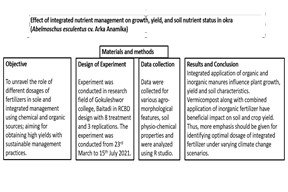Effect of integrated nutrient management on growth, yield, and soil nutrient status in okra (Abelmoschus esculentus cv. Arka Anamika)
Abstract
Okra (Abelmoschus esculentus cv. Arka Anamika) is one of the most widely grown vegetable crops in the tropics during the spring, summer, and Kharif seasons. One of the major constraints of low productivity of okra and soil deterioration is due to the inappropriate and sole use of synthetic fertilizer. So, to address the yield gap, an experiment was conducted in Gokuleshwor, Baitadi Nepal from 23rd March to 15th July 2021 to study the effect of integrated nutrient management (INM) on growth, and yield and soil nutrient status in okra". The experiment was laid out in a randomized complete block design (RCBD) with 8 treatments and 3 replication T8 gave maximum plant height (37.21 cm), stem diameter (4.04 cm), numbers of leaves (14.33), and a number of pods (8.07) and minimum plant height (23.18 cm) and a number of leaves (9.00) were observed in T3 whereas minimum steam diameter (2.87cm) a and number of pods (2.87) were observed in T6. It was observed that treatment T8 produced a maximum yield (2.10 kg) and treatment T3 produces the minimum yield (1.24 kg). Highest post-harvest available nitrogen (0.1167%), phosphorus (85.20 kg/ha), potassium (229.61 kg/ha), organic matter (2.31%) and pH (6.25) was found in treatment T8. This study suggests integrating vermicompost and synthetic fertilizer as a potential source for better growth, and high yield of okra thus more experiments on dosage optimization and SSNM should be focused onwards for long term sustainability.
Keywords:
Farmyard manure, Integrated nutrient management, Okra, VermicompostDownloads
References
Agarwal, A. K. (2003). Role of organic enrichers in management of soil salinity. Agrobios, 2, 21–23.
Damar, U., Sharma, R. K., Kushwah, S. S., & Singh, O. P. (2021). Influence of varieties, organic manures and inorganic fertilizers on growth, yield and quality of okra (Abelmoschus esculentus L.). Vegetable Science, 48(1), 73-78.
Dutta, S., Kalita, N., & Maibangsa, S. (2020). Effect of an organic source of nutrients in growth and yield parameters of Okra (Abelmoschus esculentus L.) in Karbi Anglong district of Assam. International Journal of Chemical Studies, 8(5), 1910–1913.
Etchevers Claudia Hidalgo Moreno Gina P Nilo, J. D., & Bernaldo Florfina P Sanchez, B. G. (n.d.). Standard Operating Procedure for available Phosphorus. Olsen Method.
Guragain, R. P., Baniya, H. B., Dhungana, S., Chhetri, G. K., Sedhai, B., Basnet, N., Shakya, A., Pandey, B. P., Pradhan, S. P., & Joshi, U. M. (2021). Effect of plasma treatment on the seed germination and seedling growth of radish (Raphanus sativus). Plasma Science and Technology, 24(1), 015502.
Haynes, R. J. (1980). A comparison of two modified Kjeldahl digestion techniques for multi-element plant analysis with conventional wet and dry ashing methods. Communications in Soil Science and Plant Analysis, 11(5), 459–467.
Hedge, D. M., Sreeenath, P. R., Kaur, K. C., Kumar, M., & Sharma, M. N. (1992). Cropping System Research, Annual Report, 1991-92. Project Directorate for Cropping System Research, Medipuram, Meerut.
Khanal, S., Dutta, J. P., Yadav, R. K., Pant, K. N., Shrestha, A., & Joshi, P. (2020). Response of Okra [Abelmoschus Esculentus (L.) Moench] To Nitrogen Dose and Spacing on Growth and Yield Under Mulch Condition, in Chitwan, Nepal. Journal of Clean WAS, 4(1), 40–44, https://doi.org/10.26480/jcleanwas.01.2020.40.44
Khandaker, M. M., Fadhilah Nor, M., Dalorima, T., Sajili, M. H., & Mat, N. (2017). Effect of different rates of inorganic fertilizer on physiology, growth and yield of okra (Abelmoschus esculentus) cultivated on BRIS soil of Terengganu, Malaysia. Australian Journal of Crop Science, 11(7), 880–887, https://doi.org/10.21475/ajcs.17.11.07.pne552
Mal, B., Mahapatra, P., Mohanty, S., & Mishra, H. N. (2013). Growth and yield parameters of okra (Abelmoschus esculentus) influenced by Diazotrophs and chemical fertilizers. Journal of Crop and Weed, 9(2), 109–112.
Matus, F. J., Escudey, M., Förster, J. E., Gutiérrez, M., & Chang, A. C. (2009). Is the Walkley–Black method suitable for organic carbon determination in Chilean volcanic soils? Communications in Soil Science and Plant Analysis, 40(11–12), 1862–1872.
Meena, D. C., & Meena, M. L. (2018). Effect of integrated nutrient management on growth parameters of okra (Abelmoschus esculents L. Moench). Chemical Science Review and Letters, 7(26), 582-585.
Mishra, B., Sahu, G., Tripathy, P., Mohanty, S., & Pradhan, B. (2020). Impact of organic and inorganic fertilizers on growth, yield, nutrient uptake, and soil fertility in okra (Abelmoschus esculentus (L.) Moench) cv. Pusa A-4. The Pharma Innovation Journal, 9(7), 210–213.
Olsen, S. R., & Dean, L. A. (1965). Phosphorus. Chemical and microbiological properties. Methods of Soil Analysis, Part, 2, 1035–1048.
Orozco, F. H., Cegarra, J., Trujillo, L. M., & Roig, A. (1996). Vermicomposting of coffee pulp using the earthworm Eisenia fetida: Effects on C and N contents and the availability of nutrients. Biology and Fertility of Soils, 22(2), 162–166, https://doi.org/10.1007/BF00384449
PAULINE, B. Y., & HALD, M. (1946). The flame photometer for the measurement of sodium and potassium in biological materials. The Journal of Biological Chemistry. From the Department of Internal Medicine, Yale University School of Medicine, New Haven (USA), 499–510.
Pratt, P. F. (1965). Potassium. Methods of Soil Analysis: Part 2 Chemical and Microbiological Properties, 9, 1022–1030.
Rana, M., Islam, M. M., & Bhuiyan, M. A. R. (2020). Effectiveness of integrated nutrient management on growth and yield parameters of okra (Abelmoschus esculentus L.). Asian-Australasian Journal of Food Safety and Security, 4(2), 41–48, https://doi.org/10.3329/aajfss.v4i2.53879
Sachan, S., Singh, D., Kasera, S., Mishra, S. K., Tripathi, Y., Mishra, V., & Singh, R. K. (2017). Integrated Nutrient Management (INM) in Okra (Abelmoschus esculentus L.) Moench) for Better Growth and Higher Yield. Pharmacognosy and Phytochemistry, 6(5), 1854–1856.
Sharma, R., & Chadak, S. (2022). Residual Soil Fertility, Nutrient Uptake, and Yield of Okra as Affected by Bioorganic Nutrient Sources. Communications in Soil Science and Plant Analysis, 53(21), 2853-2866.
Singh, V. B., & Tiwari, A. K. (2019). Effect of integrated nutrient management (INM) on economics of okra (Abelmoschus esculentus L) cultivation. International Journal of Farm Sciences, 9(3), 8-11.
Stewart, B. A., & Porter, L. K. (1963). Inability of the Kjeldahl method to fully measure indigenous fixed ammonium in some soils. Soil Science Society of America Journal, 27(1), 41–43.

Published
How to Cite
Issue
Section
Copyright (c) 2023 Agriculture and Environmental Science Academy

This work is licensed under a Creative Commons Attribution-NonCommercial 4.0 International License.

